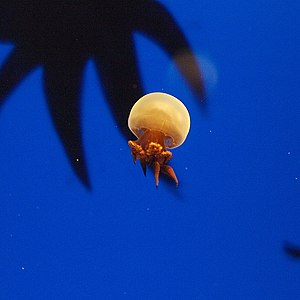Rhopilema esculentum
| Rhopilema esculentum | ||||||||||||
|---|---|---|---|---|---|---|---|---|---|---|---|---|

Rhopilema esculentum |
||||||||||||
| Systematics | ||||||||||||
|
||||||||||||
| Scientific name | ||||||||||||
| Rhopilema esculentum | ||||||||||||
| Kishinouye , 1891 |
Rhopilema esculentum (wrongly also Rhopilema esculenta ) is an edible species of jellyfish from the order of the root-mouth jellyfish (Scyphozoa). It is bred in large water tanks on the east coast of China and released into the natural habitat as young Ephyra medusas in large numbers to refresh the natural population.
description
The medusas reach an umbrella diameter of 25 to 45 cm (more rarely over 50 cm) and an umbrella height of 33 cm. The jelly of the umbrella is up to 5 cm thick in the middle. The exumbrella is smooth. Each octant has 14 to 20 oval velum lobes. Instead of the club-shaped ends, the mouth arms have numerous thread-like attachments. The species reaches a weight of 30 to 50 kg.
The cnidoma has four different types of nettle cells : a-isorhizas, o-anisorhizas, e-anisorhizas and euryteles, with the e-anisorhizas only occurring in specimens with a screen diameter of 15 to 30 mm.
Way of life
The medusa are separate sexes. The sex products are released into the open water where fertilization takes place. The first planula larvae appear about seven hours after fertilization. After three to four days, most planulae metamorphose into scyphostomae ("scyphopolypes") with initially four tentacles. The number of tentacles increases to 16 within 15 to 20 days. During this time, podocysts are also continuously formed. The strobilation and formation of Ephyra larvae takes place at 18 to 20 ° C after about two months. About six to ten ephyrae are formed. Under laboratory conditions, the ephyrae grow to a diameter of 50 mm within 30 days. Adult size is reached after about two to three months. Optimal growth of planulae, scyphostomae and ephyrae occurs under brackish conditions (14 to 22 ‰). Early stages of the Scyphostomae feed on planktonic larvae, later Scyphostomae and Ephyrae on small planktonic crustaceans, nauplius larvae and other zooplankton .
Geographical occurrence and habitat
Rhopilema esculentum occurs in the Sea of Japan , the Yellow Sea (and its subsidiary bays) and the South China Sea . The development seems to take place near the coast under brackish conditions and in shallow water.
Poisonous effect
The sting of the stinging cells of Rhopilema esculentum is very painful; especially swimmers and fishermen are affected. The syndrome often causes fever, fatigue, muscle pain, difficulty breathing, or a drop in blood pressure, and can even be fatal.
Breeding and commercial importance
2005 in China grown to 500 million Ephyrae in large water tanks and released into the open water to the natural stocks refresh and supplement. In 2005, around 50 million Rhopilema esculenta jellyfish with a total weight of around 100,000 tons were fished in Liaoning Bay , a side bay of the Yellow Sea .
Individual evidence
- ↑ Comparative Toxicogenomics Database, Mount Desert Island Biological Laboratory (CTD): Organism: Rhopilema esculentum (English, accessed July 31, 2010)
- ↑ The Encyclopedia of Life (EOL): Rhopilema esculentum Kishinouye, 1891 (English, accessed July 31, 2010)
- ^ Paul Lassenius Kramp: Synopsis of the Medusae of the World. In: Journal of the Marine Biological Association of the United Kingdom , 40, p. 243, PDF Online ( Memento of the original from October 30, 2007 in the Internet Archive ) Info: The archive link was automatically inserted and not yet checked. Please check the original and archive link according to the instructions and then remove this notice.
- ↑ a b c Kylie A. Pitt and Jennifer E. Purcell: Jellyfish Blooms: Causes, Consequences and Recent Advances. Springer Netherlands, 2009, ISBN 978-1402097485 , p. 114.
- ↑ Makoto Omori: Edible Jellyfish (Scyphomedusae: Rhizostomeae) in the Far East Waters. ( Online) ( page no longer available , search in web archives ) Info: The link was automatically marked as defective. Please check the link according to the instructions and then remove this notice.
- ↑ M. Avian, E. Spanier and B. Galil: Nematocysts of Rhopilema nomadica (Scyphozoa: Rhizostomeae), An Immigrant Jellyfish in the Eastern Mediterranean. In: Journal of Morphology , 224: 221-231, 1995
- ↑ T. Yasuda, Y. Suzuki: Notes on an Edible Medusa, Rhopilema asamushi Uchida, Caught in Wakasa Bay, Japan. ( Online) ( page no longer available , search in web archives ) Info: The link was automatically marked as defective. Please check the link according to the instructions and then remove this notice.
- ↑ WoRMS taxon details: Rhopilema esculentum Kishinouye, 1891 (English, accessed July 31, 2010)
- ↑ Huahua Yua, Xiguang Liu, Xiangli Dong, Cuiping Li, Ronge Xing, Song Liu and Pengcheng Li: Insecticidal activity of proteinous venom from tentacle of jellyfish Rhopilema esculentum Kishinouye. In: Bioorganic & Medicinal Chemistry Letters , 15 (2): 4949-4952, 2005 doi : 10.1016 / j.bmcl.2005.08.015
- ↑ Glibber for Gourmets in: Frankfurter Allgemeine Sonntagszeitung of July 31, 2011, page 49
